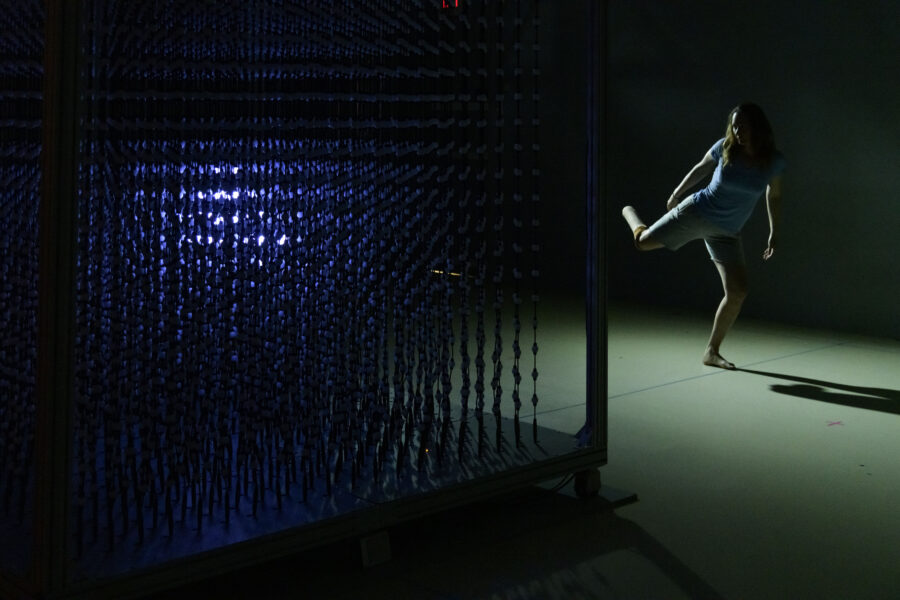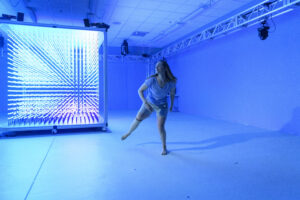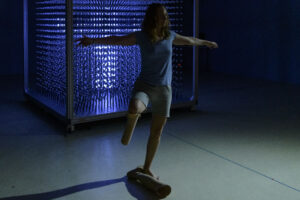Phantom Limbs: The DotBox and the crip or disabled body and mind by Kristi Hansen

As someone who is fascinated by how the crip or disabled body and mind interacts in a world that is in many ways inaccessible to our disabled or crip bodies and minds, I see technology as a great reflection of ableist rhetoric that can exist in a non-disabled society that doesn’t necessarily have the experiences of disabled people in mind. The possibility for art making with technology and the crip or disabled body and mind is heightened in this state of interaction and can help take us from the medical model of disability into a social one.
The medical model of disability says people are disabled by their impairments or differences. The social model of disability says that disability is caused by the way society is organized. The medical model looks to “fix” the disability as opposed to creating more accessible ways in which the disabled person can exist in the world with their disability under a social model (ie. A ramp for wheelchair users, full text audio-recordings for folks with visual impairments).
I believe the technology of the DotBox and Spatio Bodytech exist simultaneously in the medical and the social model of disability. In my experiments with the DotBox, we were using (from my understanding) 27 detection points on the body including the head, neck, shoulders, elbows, hands, hips, knees, and feet. We noticed right away when working sans prosthetic (I am a below knee amputee with significant limb difference on my right leg and wear a prosthesis for the majority of the time) that Spatio would try to “fill in” a right leg and foot for me where there simply wasn’t one. I immediately drew the parallel between this “glitch” and Phantom limb syndrome that many amputees experience.

Phantom limb syndrome is the feeling of sensations in a limb that has been removed. It appears that the brain continues to receive signals from the nerve endings that originally supplied signals to and from the missing limb. Phantom limb is thought to be caused by the brain rewiring itself and rearranging sensory information to adjust to the changes in the body. The glitching of Spatio and the DotBox to create a phantom limb where there wasn’t one, immediately made me want to explore how this technology worked with many different disabled bodies and minds, and how it could reflect the real world experiences of disabled bodies and minds as it had with my phantom limb. Hence, the Phantom Limbs’ research and performance project was born with the technical guidance and dramaturgical eye of Moment Discovery’s Research Director, Pamela Anthony.
As part of my research, I engaged with 3 other disabled artists: Carly Neis, a theatre artist who is a wheelchair user and lives with Cerebral Palsy and her new guide dog Gilmore; Chris Dodd, a Deaf theatre artist who communicates through speech, lip-reading, and ASL (American Sign Language); and Sissy Thiessen Kootenayoo, a spoken word, fancy dancer, and beader, who lives with brain injury and mental health issues. I was interested in each of their experiences as disabled humans and how their work would interact with the DotBox and Spatio.

Our work with Carly and Gilmore culminated in building a map specific to her entitled So Fancy creating a visual and auditory experience. Since Carly is a wheelchair user, Spatio was confused by the fact that her hips and knees were on the same plane (due to her seated position in the chair) which obscured the reading, thus creating a beautiful blur. We also noted, to our delight, that Gilmore became a part of Carly’s feet creating a large foot file. We exaggerated this reading even more to create a bright yellow foot as part of the map.
Some of the interesting conversations that came out of our time working with Carly was in regards to the parallel between what Spatio was seeing, and Cerebral Palsy in regards to Proprioception and Somatics. Proprioception is the ability to sense stimuli arising within the body regarding position, motion, and equilibrium. Somatics describes any practice that uses the mind-body connection to help you survey your internal self and listen to signals your body sends about areas of pain, discomfort, or imbalance.
Cerebral Palsy affects the motor area of the brain’s outer layer (called the cerebral cortex), the part of the brain that directs muscle movement. Just as the brain sends signals that can be obscured in the transmission to the person with Cerebral Palsy’s body, so too can the transmission from the subject’s body to Spatio’s reading be obscured and create different and artful interpretations of how the brain/body connection works with Cerebral Palsy. This was a similar finding to my own discovery of Spatio’s interpretation of the Phantom limb syndrome.
Another interesting discussion coming from our time with Carly was how Spatio and the DotBox actually “sees” her in her disabled body. As disabled humans we often can feel overlooked by society at large. The fact that there IS data coming from our bodies into Spatio and through the DotBox tells us that we are here. This is an affirming notion as a disabled person. The process of Spatio seeing the disabled body, and processing how it sees us, is deprogramming itself and society’s erasure of disabled bodies and minds.
In our work with Chris Dodd, we wanted to see how Spatio and the DotBox would interpret ASL. We hypothesized that Spatio and DotBox wouldn’t be able to register the subtleties in the language due to the large pixilation in the 20x20x20 light box but we hoped that we could continue to find artistic parallels between Deaf culture and how Spatio and the DotBox were interpreting Chris’ work. As predicted, we were not able to understand the ASL on the DotBox. We also found that when Chris’ hands are in front of body we couldn’t see them which made for even less clarity in translation. Big gestures were much more clear and certainly more interesting as an observer. Chris informed us that the head is very important in ASL so we expanded the scale on his head in Spatio and that was a happy artful truth to find in Spatio and the DotBox. One of the most successful experiments of the day was using the sound wave file in the DotBox/Spatio where the light is triggered by sound in the room. We had Chris perform an excerpt from his play, Deafy, in ASL and aurally. The way his sound danced with the lights and ASL created a very satisfying experience as an audience member experiencing Chris’ speech patterns both aurally and visually in the DotBox. It was also a way for Chris to experience sound visually even though he cannot experience it aurally which is an example of the social model of working with disability to create new ways for disabled humans to experience the world.